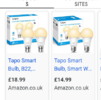Does this mean that you have to wire it up in the wires above the plasterboard of the ceiling?
Yes.
If it's just a pendant, then a box will be required in the ceiling above the pendant. Example:
https://www.screwfix.com/p/appleby-1-gang-dry-lining-circular-knockout-box-35mm/90517
If it's some other fancy light fitting, it can usually be installed inside the fitting itself. These modules are tiny.
That's an EU type of switch and box but the scale is the same as UK versions.
Or take a neutral to the light switch and fit behind the light switch.
They can theoretically be used with no neutral but that's the same problem as other devices which claim such things - additional 'bypass' or load devices are needed, and even then operation is likely to be unreliable or cause LED lamps to flash or glow dimly.
If "above the plasterboard", could you possibly point me in the direction of a wiring diagram, i
It's the same wherever it goes.
Permanent power L&N, and a switched L output to the light.
Then two wires to the light switch.
All of which should be available at the ceiling light unless some buffoon has used hidden junction boxes.
Can this sort of device potentially work with 1) low-energy bulbs? 2) LED-style downlighter bulbs? I
Yes. LED are low energy and are pretty much all there is now.
Those fluorescent affairs from some years ago are obsolete. No one uses them.
one 1-gang switch may in fact control 10 LED downlighters: would I have to have one of these devices for each downlighter?
You could, if you wanted to control all of them separately.
In reality it's more likely to just switch all 10 just as with any other switch.
Not having looked into LEDs for some time I'm not clear what sort of voltage/current they typically run on these days.
230V AC, and the current is pretty much nothing.
A typical LED downlight is around 5 watts. A 6 amp lighting circuit could have well over 200 of them.
That Shelly module can switch up to 8 amps or 2000W, , which is more than a standard UK lighting circuit of 6 amps.
maybe extending the neutral cable and dragging it down into the light switch might be as feasible as anything else?).
That is the best option, as the device can go behind the light switch and is much easier to access if and when required.
Normally done by installing 3C&E cable to the switch, so you have L, switched L and neutral.
The rest of the circuit wiring is the same as any other lighting circuit.




